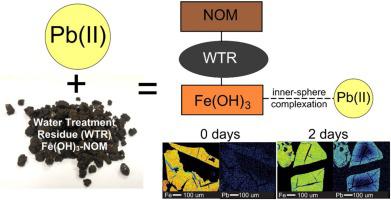Journal of Hazardous Materials ( IF 13.6 ) Pub Date : 2020-07-08 , DOI: 10.1016/j.jhazmat.2020.123433 Nina C Finlay 1 , Caroline L Peacock 2 , Karen A Hudson-Edwards 3 , Karen L Johnson 1

|
Pb contamination of soils is a global problem. This paper discusses the ability of an Fe-rich waste, water treatment residual (WTR), to adsorb Pb(II). This was investigated using batch sorption experiments, X-ray diffraction, electron microprobe microanalysis, PHREEQC modeling and Extended X-ray Absorption Fine Structure (EXAFS) analysis. The WTR is composed of approximately 23 wt. % natural organic matter (NOM), 70 wt. % ferrihydrite and <10 wt. % silicate material. Pb(II) sorption to WTR was dependent on initial Pb(II) load, particle size, time and pH, but not on ionic strength. EXAFS analysis at the Pb LIII-edge confirmed that Pb(II) sorbed to WTR by co-existing bidentate edge-sharing and monodentate or corner-sharing complexes, with 2 O at ∼2.31–2.34 Å, 1 Fe at ∼3.32–3.34 Å, 2 Fe at ∼3.97–3.99 Å and 1 Pb at ∼3.82–3.85 Å. Linear combination showed that the Pb(II)-sorbed spectra were best fit with a ∼0.9 ± 0.1 and 0.1 ± 0.1 contribution from Pb(II)-sorbed ferrihydrite and Pb(II)-sorbed humic acid end members, respectively. Overall, we show that Pb(II) sorbs via strong inner-sphere complexation of Pb(II) to the ferrihydrite component of the WTR, which itself is stable over a wide pH range. Therefore, we suggest that Fe-rich WTR wastes could be used as effective adsorbents in Pb(II)-contaminated soils to help ensure sustainable terrestrial ecosystems.
中文翻译:

富铁废水处理残留物(WTR)上Pb(II)的吸附特征和机理:一种潜在的可持续Pb固定化土壤技术。
铅对土壤的污染是一个全球性问题。本文讨论了富铁废物,水处理残留物(WTR)吸附Pb(II)的能力。使用批量吸附实验,X射线衍射,电子微探针显微分析,PHREEQC建模和扩展X射线吸收精细结构(EXAFS)分析对此进行了研究。WTR由大约23 wt。%自然有机物(NOM),70 wt。亚铁酸盐百分比和<10 wt。%硅酸盐材料。Pb(II)对WTR的吸附取决于初始Pb(II)负载,粒径,时间和pH,但不取决于离子强度。Pb L III的EXAFS分析-edge证实Pb(II)通过并存的二齿边缘共享和单齿或角共享复合体吸附到WTR,其中2 O在〜2.31–2.34Å,1 Fe在〜3.32-3.34Å,2 Fe在〜 3.97–3.99Å和1 Pb在〜3.82–3.85Å下。线性组合表明,Pb(II)吸附的光谱最合适,分别由Pb(II)吸附的三水铁矿和Pb(II)吸附的腐殖酸端基贡献约0.9±0.1和0.1±0.1。总体而言,我们表明Pb(II)通过Pb(II)与WTR的亚铁水合物组分之间的强内球络合而吸收,而WTR的亚铁水合物本身在很宽的pH范围内都是稳定的。因此,我们建议将富含铁的WTR废物用作受Pb(II)污染的土壤中的有效吸附剂,以帮助确保可持续的陆地生态系统。


























 京公网安备 11010802027423号
京公网安备 11010802027423号